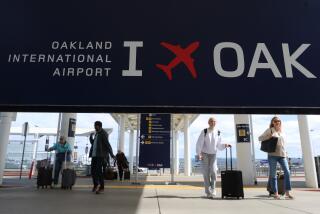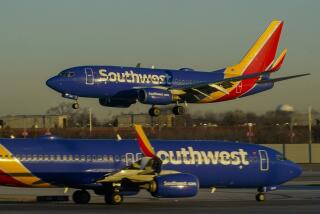O.C. Air Service by 2nd Low-Cost Carrier Nears
- Share via
SANTA ANA — Just a week after John Wayne Airport got its first low-fare airline, the Orange County Airport Commission on Wednesday moved to allow a second discount carrier to begin service to San Jose, possibly by the end of this month.
Reno Air would be allowed to take over flights that American Airlines wants to drop because it is losing money competing with the other low-cost carrier, Southwest Airlines, on the route.
Southwest, which started service last week to San Jose and Oakland, cut the fare that American and other carriers were charging nearly in half to a flat $69 one way. While Reno Air has not indicated what it would charge, its everyday fare from Los Angeles International Airport to San Jose is $72 one way.
Reno Air sought approval in February to start service at John Wayne but was rebuffed because there were not enough landing slots available. This time, however, Reno Air plans to operate through its strategic relationship with American Airlines, using some of its slots. The arrangement could benefit both carriers.
“I think it’s extremely cost effective and logical and prudent to do what they are doing here,” said Commissioner Robert L. Cashman before the 3-0 vote. “The approach they are taking is the wave of the future.”
American Airlines has matched Southwest’s fare to San Jose, but an American spokesman said the route is unprofitable given its competitor’s lower costs. Linking with Reno Air would be an alternative to ending its service.
Though it is independently owned and run, Nevada-based Reno Air has a relationship with American that goes beyond trying to pick up unneeded landing slots at John Wayne.
Reno Air offers its passengers credit on American Airlines frequent flyer program. And by flying some or all of the six daily flights to San Jose that American would be giving up, Reno Air could feed passengers from its twin-engine MD-80 jetliners onto American’s profitable connecting flights.
The proposed arrangement, however, is causing some concern among county airport officials.
That’s because Reno Air, by virtue of its link with American, is being allowed to hopscotch ahead of at least one other airline--Mark Air--on the waiting list to start Orange County service.
As a result, Airport Director Jan Mittermeier said she is recommending the entry of 2-year-old Reno Air only on a conditional basis through September while the issue is studied further.
“This is an exception to the rule, a onetime shot,” she said.
She added, however, that she has so far heard of no objections from executives of other carriers, including Mark Air, who are being solicited for their views. The Reno Air deal is also subject to a review of the contracts by the Airport Commission and by a vote of the Orange County Board of Supervisors.
While allowing one airline to pass its unused slots to another might not have been considered possible in the past, it is now being viewed as a solution to changes sweeping the airline industry.
The fundamental change is what analysts see as the emergence of two kinds of service. Flights of less than two hours increasingly are characterized by basic, inexpensive service--rather like a flying interstate bus. Longer flights continue to offer in-flight movies, meals and other niceties that passengers have come to expect.
On the short flights, the pioneer has been Southwest.
Among other things, it keeps its planes in the air making money rather than sitting on the ground. It reduces costs by eliminating meals, baggage transfers and travel agents’ computerized reservations systems.
Passing its savings on to the customer, the Dallas-based carrier has seen its profits soar as the rest of the airline industry has sputtered in the past few years.
Now some of the titans are thinking of creating or spinning off sister carriers that can compete with the likes of Southwest. Continental Airlines has created low-cost, no-frills CALite, which plies routes in the East; United Airlines is pondering whether to start a new service dubbed U2, which would operate the same way.
As the new carriers work their way to Orange County, airport officials will need to decide how to treat these new upstarts. Are the new airlines required to wait in line for landing slots like all the others? Or are they simply extensions of their sister carriers, entitled to fly any of their unused slots?
It’s a problem of “two bites of the same apple,” as Mittermeier puts it.
Still, it’s an issue the airport needs to consider to stay abreast of the latest events in the industry.
“A rule good five years ago may not be as good today,” Mittermeier said.
More to Read
Inside the business of entertainment
The Wide Shot brings you news, analysis and insights on everything from streaming wars to production — and what it all means for the future.
You may occasionally receive promotional content from the Los Angeles Times.










